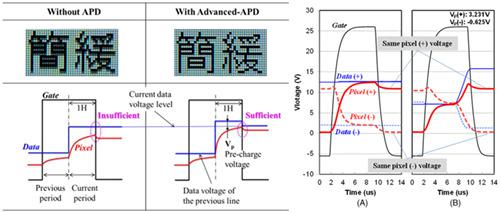当前位置:
X-MOL 学术
›
J. Soc. Inf. Disp.
›
论文详情
Our official English website, www.x-mol.net, welcomes your feedback! (Note: you will need to create a separate account there.)
Improvement for image‐sticking phenomenon occurred in 8K‐liquid crystal displays with adaptive pre‐charge driving technique
Journal of the Society for Information Display ( IF 2.3 ) Pub Date : 2020-09-15 , DOI: 10.1002/jsid.964 Ryutaro Oke 1 , Teruhisa Nakagawa 1
Journal of the Society for Information Display ( IF 2.3 ) Pub Date : 2020-09-15 , DOI: 10.1002/jsid.964 Ryutaro Oke 1 , Teruhisa Nakagawa 1
Affiliation

|
We proposed adaptive pre‐charge driving (APD) technique that is appropriate for large‐size and high‐resolution liquid crystal display (LCD) panels for TVs to compensate the shortage of charging voltage to a pixel. APD technique enables to realize LCD panels of 8K resolution even though thin‐film‐transistor (TFT) is amorphous‐Si. Recently, this APD renamed line‐overdrive (line‐OD), and it has been reported to be applied to 8K‐LCD panels, and its technical value is increasing. This paper describes an image‐sticking phenomenon with APD. We have made clear that this phenomenon is triggered by the residual DC that was created by the charging performance to the pixel of positive polarity being inferior to the charging performance to that of negative polarity. To solve this issue, it further explains how best to optimize the pre‐charge table for positive and negative polarities, respectively, by effectively using the high‐precision pixel simulation.
中文翻译:

自适应预充电驱动技术改善了8K液晶显示器中的图像残留现象
我们提出了自适应预充电驱动(APD)技术,该技术适用于电视的大尺寸和高分辨率液晶面板(LCD),以补偿像素充电电压的不足。即使薄膜晶体管(TFT)是非晶硅,APD技术也可以实现8K分辨率的LCD面板。最近,该APD重命名为line-overdrive(line-OD),据报道已应用于8K-LCD面板,其技术价值正在不断提高。本文介绍了APD的图像残留现象。我们已经清楚地表明,这种现象是由残留DC触发的,该残留DC是由对正极性像素的充电性能劣于负极性的像素的充电性能所产生的。为了解决这个问题,
更新日期:2020-09-15
中文翻译:

自适应预充电驱动技术改善了8K液晶显示器中的图像残留现象
我们提出了自适应预充电驱动(APD)技术,该技术适用于电视的大尺寸和高分辨率液晶面板(LCD),以补偿像素充电电压的不足。即使薄膜晶体管(TFT)是非晶硅,APD技术也可以实现8K分辨率的LCD面板。最近,该APD重命名为line-overdrive(line-OD),据报道已应用于8K-LCD面板,其技术价值正在不断提高。本文介绍了APD的图像残留现象。我们已经清楚地表明,这种现象是由残留DC触发的,该残留DC是由对正极性像素的充电性能劣于负极性的像素的充电性能所产生的。为了解决这个问题,



























 京公网安备 11010802027423号
京公网安备 11010802027423号